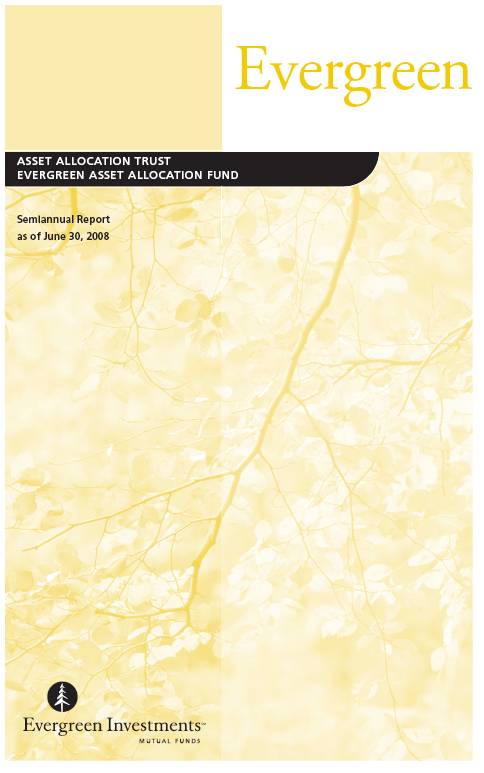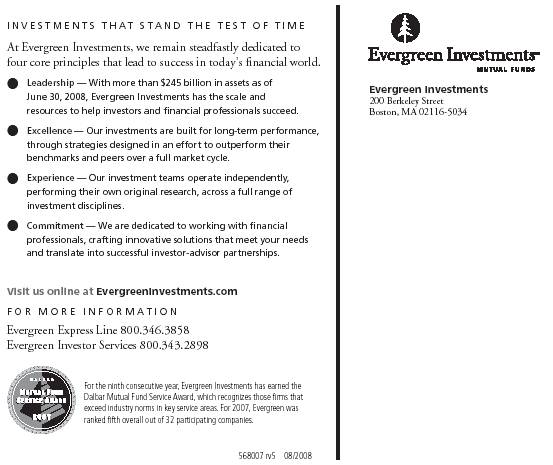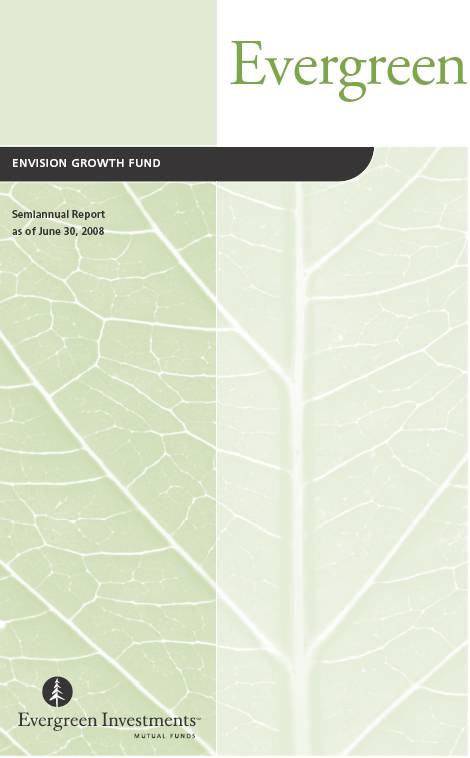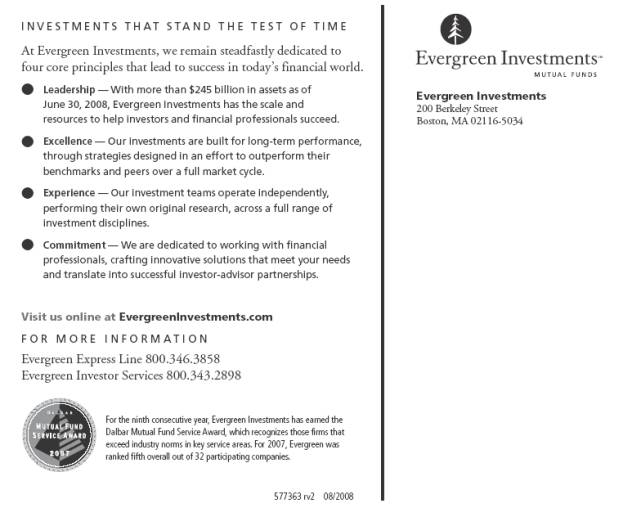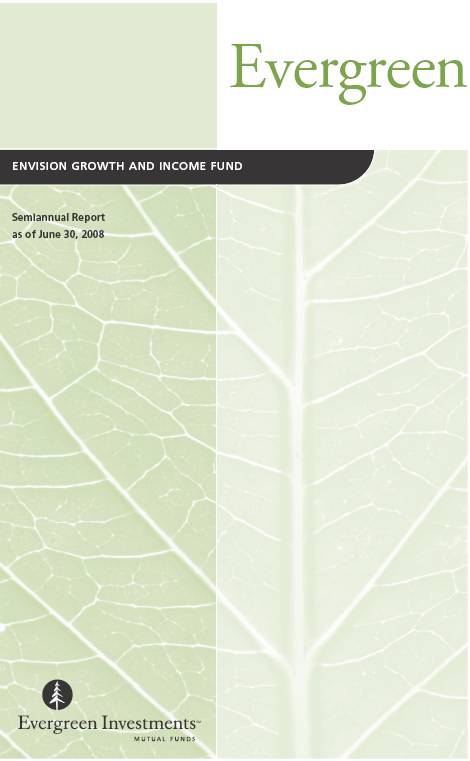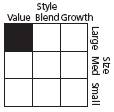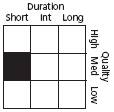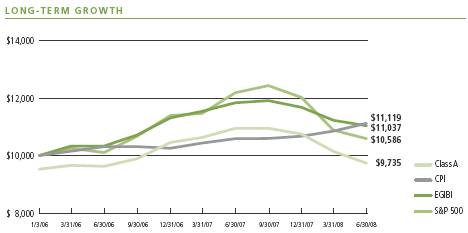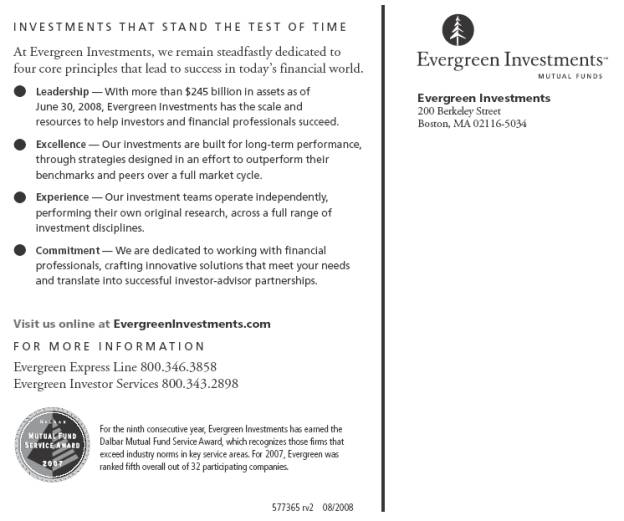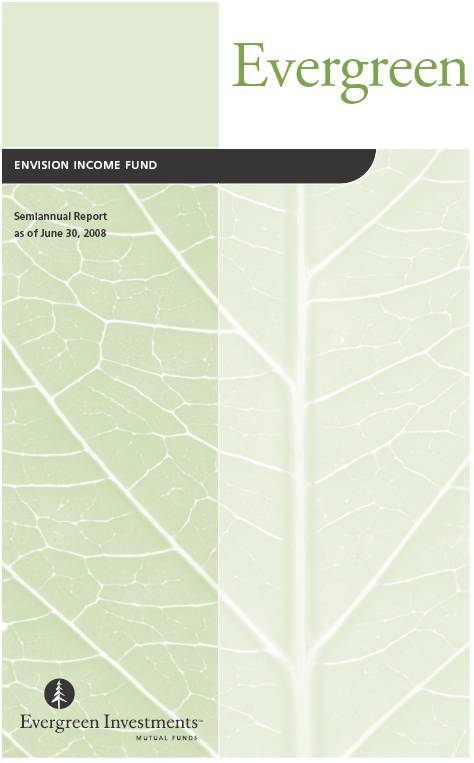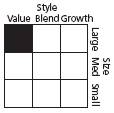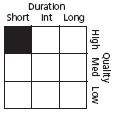Matthew S. Wedding
Source: Morningstar, Inc.
Morningstar’s style box is based on a portfolio date as of 6/30/2008.
The style box is representative of the investments in the underlying funds.
The Equity style box placement is based on 10 growth and valuation measures for each fund holding and the median size of the companies in which the fund invests.
The Fixed Income style box placement is based on a Fund’s average effective maturity or duration and the average credit rating of the bond portfolio.
The fund incurs a 12b-1 fee of 0.25% for Class A and 1.00% for Classes B and C. Class I does not pay a 12b-1 fee.
The advisor is reimbursing the fund for a portion of other expenses. Had the expenses not been reimbursed, returns would have been lower. Returns reflect expense limits previously in effect for Class A, without which returns for Class A would have been lower.
FUND AT A GLANCE continued
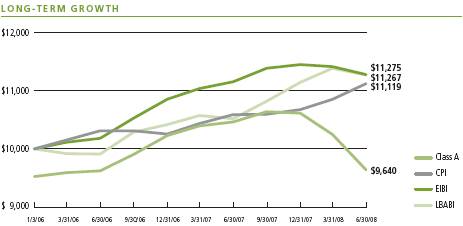
Comparison of a $10,000 investment in the Evergreen Envision Income Fund Class A shares versus a similar investment in the Envision Income Blended Index (EIBI), the Lehman Brothers Aggregate Bond Index (LBABI) and the Consumer Price Index (CPI).
The EIBI and the LBABI are unmanaged market indexes and do not include transaction costs associated with buying and selling securities, any mutual fund fees or expenses or any taxes. The CPI is a commonly used measure of inflation and does not represent an investment return. It is not possible to invest directly in an index.
Class I shares are only offered, subject to the minimum initial purchase requirements, in the following manner: (1) to investment advisory clients of EIMC (or its advisory affiliates), (2) to employer- or state-sponsored benefit plans, including but not limited to, retirement plans, defined benefit plans, deferred compensation plans, or savings plans, (3) to fee-based mutual fund wrap accounts, (4) through arrangements entered into on behalf of the Evergreen funds with certain financial services firms, (5) to certain institutional investors, and (6) to persons who owned Class Y shares in registered name in an Evergreen fund on or before December 31, 1994 or who owned shares of any SouthTrust fund in registered name as of March 18, 2005 or who owned shares of Vestaur Securities Fund as of May 20, 2005.
Class I shares are only available to institutional shareholders with a minimum of $1 million investment, which may be waived in certain situations.
The fund’s investment objective may be changed without a vote of the fund’s shareholders.
Foreign investments may contain more risk due to the inherent risks associated with changing political climates, foreign market instability and foreign currency fluctuations. Risks of international investing are magnified in emerging or developing markets.
The return of principal is not guaranteed due to fluctuation in the fund’s NAV caused by changes in the price of individual bonds held by the underlying funds and the buying and selling of bonds by the underlying funds. Bond funds have the same inflation, interest rate and credit risks as the individual bonds held by the underlying funds. Generally, the value of bond funds rises when prevailing interest rates fall, and falls when interest rates rise.
Asset-backed and mortgage-backed securities are generally subject to higher prepayment risks than other types of debt securities, which can limit the potential for gain in a declining interest rate environment and increase the potential for loss in a rising interest rate environment. Mortgage-backed securities may also be structured so that they are particularly sensitive to interest rates.
Derivatives involve additional risks including interest rate risk, credit risk, the risk of improper valuation and the risk of non-correlation to the relevant instruments they are designed to hedge or to closely track.
High yield, lower-rated bonds may contain more risk due to the increased possibility of default.
U.S. government guarantees apply only to certain securities held in the fund’s portfolio and not to the fund’s shares.
Leverage may disproportionately increase a fund’s portfolio losses and reduce opportunities for gain when interest rates, stock prices, or currency rates are changing.
The Envision Income Blended Index is composed of the following indexes: LBABI (33%), LBGC0-2.5YI (27%), Russell 1000 Value (14.5%), MLHYMI† (13.5%), JPMGXUS (7%) and MSCI EAFE Free (5%).
Because the fund invests primarily in other mutual funds, the fund will incur fees and expenses indirectly as a shareholder of the underlying funds.
For more information regarding the expenses of the underlying funds, see the fund’s prospectus.
† | Copyright 2008. Merrill Lynch, Pierce, Fenner & Smith Incorporated. All rights reserved. |
All data is as of June 30, 2008, and subject to change.
5
ABOUT YOUR FUND’S EXPENSES
The Example below is intended to describe the fees and expenses borne by shareholders and the impact of those costs on your investment.
Example
As a shareholder of the fund, you incur two types of costs: (1) transaction costs, including sales charges (loads), redemption fees and exchange fees; and (2) ongoing costs, including management fees, distribution (12b-1) fees and other fund expenses. This Example is intended to help you understand your ongoing costs (in dollars) of investing in the fund and to compare these costs with the ongoing costs of investing in other mutual funds. The Example is based on an investment of $1,000 invested at the beginning of the period and held for the entire period from January 1, 2008 to June 30, 2008.
The example illustrates your fund’s costs in two ways:
• Actual expenses
The section in the table under the heading “Actual” provides information about actual account values and actual expenses. You may use the information in these columns, together with the amount you invested, to estimate the expenses that you paid over the period. Simply divide your account value by $1,000 (for example, an $8,600 account value divided by $1,000 = 8.6), then multiply the result by the number in the appropriate column for your share class, in the column entitled “Expenses Paid During Period” to estimate the expenses you paid on your account during this period.
• Hypothetical example for comparison purposes
The section in the table under the heading “Hypothetical (5% return before expenses)” provides information about hypothetical account values and hypothetical expenses based on the fund’s actual expense ratio and an assumed rate of return of 5% per year before expenses, which is not the fund’s actual return. The hypothetical account values and expenses may not be used to estimate the actual ending account balance or expenses you paid for the period. You may use this information to compare the ongoing costs of investing in the fund and other funds. To do so, compare this 5% hypothetical example with the 5% hypothetical examples that appear in the shareholder reports of the other funds.
Please note that the expenses shown in the table are meant to highlight your ongoing costs only and do not reflect any transactional costs, such as sales charges (loads), redemption fees or exchange fees. Therefore, the section in the table under the heading “Hypothetical (5% return before expenses)” is useful in comparing ongoing costs only, and will not help you determine the relative total costs of owning different funds. In addition, if these transactional costs were included, your costs would have been higher.
6
ABOUT YOUR FUND’S EXPENSES continued
| Beginning
Account Value
1/1/2008 | Ending
Account Value
6/30/2008 | Expenses Paid
During Period* |
|
|
|
|
Actual | | | |
Class A | $ 1,000.00 | $ 908.24 | $ 2.89 |
Class B | $ 1,000.00 | $ 904.42 | $ 6.44 |
Class C | $ 1,000.00 | $ 904.78 | $ 6.44 |
Class I | $ 1,000.00 | $ 908.39 | $ 1.71 |
Hypothetical
(5% return before expenses) | | | |
Class A | $ 1,000.00 | $ 1,021.83 | $ 3.07 |
Class B | $ 1,000.00 | $ 1,018.10 | $ 6.82 |
Class C | $ 1,000.00 | $ 1,018.10 | $ 6.82 |
Class I | $ 1,000.00 | $ 1,023.07 | $ 1.81 |
* | For each class of the fund, expenses are equal to the annualized expense ratio of each class (0.61% for Class A, 1.36% for Class B, 1.36% for Class C and 0.36% for Class I), multiplied by the average account value over the period, multiplied by 182 / 366 days. |
| Beginning
Account Value
1/1/2008 | Ending
Account Value
6/30/2008 | Expenses Paid
During Period** |
|
|
|
|
Actual | | | |
Class A | $ 1,000.00 | $ 908.24 | $ 6.17 |
Class B | $ 1,000.00 | $ 904.42 | $ 9.71 |
Class C | $ 1,000.00 | $ 904.78 | $ 9.71 |
Class I | $ 1,000.00 | $ 908.39 | $ 4.98 |
Hypothetical
(5% return before expenses) | | | |
Class A | $ 1,000.00 | $ 1,018.40 | $ 6.52 |
Class B | $ 1,000.00 | $ 1,014.67 | $ 10.27 |
Class C | $ 1,000.00 | $ 1,014.67 | $ 10.27 |
Class I | $ 1,000.00 | $ 1,019.64 | $ 5.27 |
** | The expense ratios include the fund’s direct operating expenses as of 6/30/08 and the indirect expenses of the underlying funds in which the fund invests. The indirect expenses were estimated to be 0.69%. For each class of the fund, expenses are equal to the annualized expense ratio of each class (1.30% for Class A, 2.05% for Class B, 2.05% for Class C and 1.05% for Class I), multiplied by the average account value over the period, multiplied by 182 / 366 days. |
7
FINANCIAL HIGHLIGHTS
(For a share outstanding throughout each period)
CLASS A | | Six Months Ended
June 30, 2008
(unaudited) | | Year Ended December 31, |
|
|
| 2007 | | 20061 |
|
|
|
|
|
|
|
Net asset value, beginning of period | | $ | 10.36 | | $ | 10.49 | | $ | 10.00 |
|
|
|
|
|
|
|
|
|
|
Income from investment operations | | | | | | | | | |
Net investment income (loss) | | | 0.24 | | | 0.46 | | | 0.21 |
Net realized and unrealized gains or losses on investments | | | (1.18) | | | (0.07) | | | 0.52 |
| |
|
|
|
|
|
|
|
|
Total from investment operations | | | (0.94) | | | 0.39 | | | 0.73 |
|
|
|
|
|
|
|
|
|
|
Distributions to shareholders from | | | | | | | | | |
Net investment income | | | (0.25) | | | (0.45) | | | (0.23) |
Net realized gains | | | (0.10) | | | (0.07) | | | (0.01) |
| |
|
|
|
|
|
|
|
|
Total distributions to shareholders | | | (0.35) | | | (0.52) | | | (0.24) |
|
|
|
|
|
|
|
|
|
|
Net asset value, end of period | | $ | 9.07 | | $ | 10.36 | | $ | 10.49 |
|
|
|
|
|
|
|
|
|
|
Total return2 | | | (9.18)% | | | 3.76% | | | 7.39% |
|
|
|
|
|
|
|
|
|
|
Ratios and supplemental data | | | | | | | | | |
Net assets, end of period (thousands) | | $ | 9,217 | | $ | 13,327 | | $ | 1,112 |
Ratios to average net assets | | | | | | | | | |
Expenses including waivers/reimbursements but excluding expense reductions | | | 0.61%3 | | | 0.61% | | | 0.62%3 |
Expenses excluding waivers/reimbursements and expense reductions | | | 1.48%3 | | | 1.32% | | | 10.89%3 |
Net investment income (loss) | | | 4.52%3 | | | 4.45% | | | 4.48%3 |
Portfolio turnover rate | | | 28% | | | 142% | | | 44% |
|
|
|
|
|
|
|
|
|
|
1 | For the period from January 3, 2006 (commencement of class operations), to December 31, 2006. |
2 | Excluding applicable sales charges |
See Notes to Financial Statements
8
FINANCIAL HIGHLIGHTS
(For a share outstanding throughout each period)
CLASS B | | Six Months Ended
June 30, 2008
(unaudited) | | Year Ended December 31, |
|
|
| 2007 | | 20061 |
|
|
|
|
|
|
|
Net asset value, beginning of period | | $ | 10.34 | | $ | 10.47 | | $ | 10.00 |
|
|
|
|
|
|
|
|
|
|
Income from investment operations | | | | | | | | | |
Net investment income (loss) | | | 0.19 | | | 0.36 | | | 0.23 |
Net realized and unrealized gains or losses on investments | | | (1.17) | | | (0.05) | | | 0.45 |
| |
|
|
|
|
|
|
|
|
Total from investment operations | | | (0.98) | | | 0.31 | | | 0.68 |
|
|
|
|
|
|
|
|
|
|
Distributions to shareholders from | | | | | | | | | |
Net investment income | | | (0.21) | | | (0.37) | | | (0.20) |
Net realized gains | | | (0.10) | | | (0.07) | | | (0.01) |
| |
|
|
|
|
|
|
|
|
Total distributions to shareholders | | | (0.31) | | | (0.44) | | | (0.21) |
|
|
|
|
|
|
|
|
|
|
Net asset value, end of period | | $ | 9.05 | | $ | 10.34 | | $ | 10.47 |
|
|
|
|
|
|
|
|
|
|
Total return2 | | | (9.56)% | | | 3.02% | | | 6.80% |
|
|
|
|
|
|
|
|
|
|
Ratios and supplemental data | | | | | | | | | |
Net assets, end of period (thousands) | | $ | 1,020 | | $ | 999 | | $ | 870 |
Ratios to average net assets | | | | | | | | | |
Expenses including waivers/reimbursements but excluding expense reductions | | | 1.36%3 | | | 1.36% | | | 1.36%3 |
Expenses excluding waivers/reimbursements and expense reductions | | | 2.20%3 | | | 2.02% | | | 11.58%3 |
Net investment income (loss) | | | 3.85%3 | | | 3.54% | | | 3.66%3 |
Portfolio turnover rate | | | 28% | | | 142% | | | 44% |
|
|
|
|
|
|
|
|
|
|
1 | For the period from January 3, 2006 (commencement of class operations), to December 31, 2006. |
2 | Excluding applicable sales charges |
See Notes to Financial Statements
9
FINANCIAL HIGHLIGHTS
(For a share outstanding throughout each period)
CLASS C | | Six Months Ended
June 30, 2008
(unaudited) | | Year Ended December 31, |
|
2007 | | 20061 |
|
|
|
|
|
|
|
Net asset value, beginning of period | | $ | 10.34 | | $ | 10.47 | | $ | 10.00 |
|
|
|
|
|
|
|
|
|
|
Income from investment operations | | | | | | | | | |
Net investment income (loss) | | | 0.192 | | | 0.38 | | | 0.24 |
Net realized and unrealized gains or losses on investments | | | (1.17) | | | (0.07) | | | 0.44 |
| |
|
|
|
|
|
|
|
|
Total from investment operations | | | (0.98) | | | 0.31 | | | 0.68 |
|
|
|
|
|
|
|
|
|
|
Distributions to shareholders from | | | | | | | | | |
Net investment income | | | (0.22) | | | (0.37) | | | (0.20) |
Net realized gains | | | (0.10) | | | (0.07) | | | (0.01) |
| |
|
|
|
|
|
|
|
|
Total distributions to shareholders | | | (0.32) | | | (0.44) | | | (0.21) |
|
|
|
|
|
|
|
|
|
|
Net asset value, end of period | | $ | 9.04 | | $ | 10.34 | | $ | 10.47 |
|
|
|
|
|
|
|
|
|
|
Total return3 | | | (9.52)% | | | 2.93% | | | 6.81% |
|
|
|
|
|
|
|
|
|
|
Ratios and supplemental data | | | | | | | | | |
Net assets, end of period (thousands) | | $ | 245 | | $ | 204 | | $ | 315 |
Ratios to average net assets | | | | | | | | | |
Expenses including waivers/reimbursements but excluding expense reductions | | | 1.36%4 | | | 1.36% | | | 1.36%4 |
Expenses excluding waivers/reimbursements and expense reductions | | | 2.20%4 | | | 2.02% | | | 11.58%4 |
Net investment income (loss) | | | 3.91%4 | | | 3.49% | | | 3.61%4 |
Portfolio turnover rate | | | 28% | | | 142% | | | 44% |
|
|
|
|
|
|
|
|
|
|
1 | For the period from January 3, 2006 (commencement of class operations), to December 31, 2006. |
2 | Net Investment income (loss) per share is based on average shares outstanding during the period. |
3 | Excluding applicable sales charges |
See Notes to Financial Statements
10
FINANCIAL HIGHLIGHTS
(For a share outstanding throughout each period)
CLASS I | | Six Months Ended
June 30, 2008
(unaudited) | | Year Ended December 31, |
|
2007 | | 20061 |
|
|
|
|
|
|
|
Net asset value, beginning of period | | $ | 10.35 | | $ | 10.48 | | $ | 10.00 |
|
|
|
|
|
|
|
|
|
|
Income from investment operations | | | | | | | | | |
Net investment income (loss) | | | 0.27 | | | 0.522 | | | 0.20 |
Net realized and unrealized gains or losses on investments | | | (1.21) | | | (0.10) | | | 0.55 |
| |
|
|
|
|
|
|
|
|
Total from investment operations | | | (0.94) | | | 0.42 | | | 0.75 |
|
|
|
|
|
|
|
|
|
|
Distributions to shareholders from | | | | | | | | | |
Net investment income | | | (0.26) | | | (0.48) | | | (0.26) |
Net realized gains | | | (0.10) | | | (0.07) | | | (0.01) |
| |
|
|
|
|
|
|
|
|
Total distributions to shareholders | | | (0.36) | | | (0.55) | | | (0.27) |
|
|
|
|
|
|
|
|
|
|
Net asset value, end of period | | $ | 9.05 | | $ | 10.35 | | $ | 10.48 |
|
|
|
|
|
|
|
|
|
|
Total return | | | (9.16)% | | | 4.04% | | | 7.57% |
|
|
|
|
|
|
|
|
|
|
Ratios and supplemental data | | | | | | | | | |
Net assets, end of period (thousands) | | $ | 99 | | $ | 89 | | $ | 13 |
Ratios to average net assets | | | | | | | | | |
Expenses including waivers/reimbursements but excluding expense reductions | | | 0.36%3 | | | 0.37% | | | 0.39%3 |
Expenses excluding waivers/reimbursements and expense reductions | | | 1.20%3 | | | 1.03% | | | 10.61%3 |
Net investment income (loss) | | | 4.79%3 | | | 4.96% | | | 5.42%3 |
Portfolio turnover rate | | | 28% | | | 142% | | | 44% |
|
|
|
|
|
|
|
|
|
|
1 | For the period from January 3, 2006 (commencement of class operations), to December 31, 2006. |
2 | Net investment income (loss) per share is based on average shares outstanding during the period. |
See Notes to Financial Statements
11
SCHEDULE OF INVESTMENTS
June 30, 2008 (unaudited)
| | Shares | | Value |
|
|
|
|
|
MUTUAL FUND SHARES 100.4% | | | | | |
INTERNATIONAL EQUITY 5.3% | | | | | |
Evergreen International Equity Fund, Class I ø | | 58,353 | | $ | 560,769 |
| | | |
|
|
INTERNATIONAL FIXED INCOME 7.1% | | | | | |
Evergreen International Bond Fund, Class I ø | | 65,200 | | | 752,404 |
| | | |
|
|
U.S. EQUITY 14.9% | | | | | |
Evergreen Disciplined Value Fund, Class I ø | | 114,096 | | | 1,571,106 |
| | | |
|
|
U.S. FIXED INCOME 73.1% | | | | | |
Evergreen Adjustable Rate Fund, Class I ø | | 270,769 | | | 2,477,534 |
Evergreen Core Bond Fund, Class I ø | | 388,043 | | | 3,701,932 |
Evergreen High Income Fund, Class I ø | | 511,808 | | | 1,555,897 |
| | | |
|
|
| | | | | 7,735,363 |
| | | |
|
|
Total Investments (cost $11,714,610) 100.4% | | | | | 10,619,642 |
Other Assets and Liabilities (0.4%) | | | | | (38,677) |
| | | |
|
|
Net Assets 100.0% | | | | $ | 10,580,965 |
| | | |
|
|
ø | Evergreen Investment Management Company, LLC is the investment advisor to both the Fund and the underlying fund. |
The following table shows portfolio composition as a percentage of total Investments as of June 30, 2008:
Mutual Fund Shares-Fixed Income | | 79.9% |
Mutual Fund Shares-Equity | | 20.1% |
| |
|
| | 100.0% |
| |
|
The following table shows the percent of total investments by sector as of June 30, 2008:
U.S. Fixed Income | | 72.8% |
U.S. Equity | | 14.8% |
International Fixed Income | | 7.1% |
International Equity | | 5.3% |
| |
|
| | 100.0% |
| |
|
See Notes to Financial Statements
12
STATEMENT OF ASSETS AND LIABILITIES
June 30, 2008 (unaudited)
Assets | | | |
Investments in affiliates, at value (cost $11,714,610) | | $ | 10,619,642 |
Receivable for investments sold | | | 25,675 |
Receivable for Fund shares sold | | | 1,114 |
Dividends receivable | | | 41,987 |
Receivable from investment advisor | | | 322 |
Prepaid expenses and other assets | | | 42,609 |
|
|
|
|
Total assets | | | 10,731,349 |
|
|
|
|
Liabilities | | | |
Dividends payable | | | 15,832 |
Payable for Fund shares redeemed | | | 89,819 |
Due to custodian bank | | | 25,672 |
Distribution Plan expenses payable | | | 99 |
Due to other related parties | | | 93 |
Printing and postage expenses payable | | | 13,188 |
Accrued expenses and other liabilities | | | 5,681 |
|
|
|
|
Total liabilities | | | 150,384 |
|
|
|
|
Net assets | | $ | 10,580,965 |
|
|
|
|
Net assets represented by | | | |
Paid-in capital | | $ | 12,542,623 |
Undistributed net investment income | | | 1,728 |
Accumulated net realized losses on investments | | | (868,418) |
Net unrealized losses on investments | | | (1,094,968) |
|
|
|
|
Total net assets | | $ | 10,580,965 |
|
|
|
|
Net assets consists of | | | |
Class A | | $ | 9,216,931 |
Class B | | | 1,019,870 |
Class C | | | 244,979 |
Class I | | | 99,185 |
|
|
|
|
Total net assets | | $ | 10,580,965 |
|
|
|
|
Shares outstanding (unlimited number of shares authorized) | | | |
Class A | | | 1,016,567 |
Class B | | | 112,685 |
Class C | | | 27,089 |
Class I | | | 10,954 |
|
|
|
|
Net asset value per share | | | |
Class A | | $ | 9.07 |
Class A — Offering price (based on sales charge of 4.75%) | | $ | 9.52 |
Class B | | $ | 9.05 |
Class C | | $ | 9.04 |
Class I | | $ | 9.05 |
|
|
|
|
See Notes to Financial Statements
13
STATEMENT OF OPERATIONS
Six Months Ended June 30, 2008 (unaudited)
Investment Income | | | |
Dividends from affiliated investment company shares | | $ | 319,189 |
|
|
|
|
Expenses | | | |
Distribution Plan expenses | | | |
Class A | | | 15,187 |
Class B | | | 5,300 |
Class C | | | 1,255 |
Transfer agent fees | | | 12,389 |
Trustees’ fees and expenses | | | 224 |
Printing and postage expenses | | | 12,494 |
Custodian and accounting fees | | | 2,461 |
Registration and filing fees | | | 32,985 |
Professional fees | | | 12,260 |
Other | | | 1,902 |
|
|
|
|
Total expenses | | | 96,457 |
Less: Expense reductions | | | (70) |
Expense reimbursements | | | (53,767) |
|
|
|
|
Net expenses | | | 42,620 |
|
|
|
|
Net investment income | | | 276,569 |
|
|
|
|
Net realized and unrealized gains or losses on investments | | | |
Net realized losses on sale of affiliated investment company shares | | | (825,419) |
Net change in unrealized gains or losses on investments | | | (612,078) |
|
|
|
|
Net realized and unrealized gains or losses on investments | | | (1,437,497) |
|
|
|
|
Net decrease in net assets resulting from operations | | $ | (1,160,928) |
|
|
|
|
See Notes to Financial Statements
14
STATEMENTS OF CHANGES IN NET ASSETS
| | | Six Months Ended
June 30, 2008
(unaudited) | | | Year Ended
December 31, 2007 | |
|
|
|
|
|
|
|
|
Operations | | | | | | | | | | | | | |
Net investment income | | | | | $ | 276,569 | | | | | $ | 517,995 | |
Net realized gains or losses on investments | | | | | | (825,419) | | | | | | 112,547 | |
Net change in unrealized gains or losses on investments | | | | | | (612,078) | | | | | | (528,360) | |
|
|
|
|
|
|
|
|
|
|
|
|
|
|
Net increase (decrease) in net assets resulting from operations | | | | | | (1,160,928) | | | | | | 102,182 | |
|
|
|
|
|
|
|
|
|
|
|
|
|
|
Distributions to shareholders from | | | | | | | | | | | | | |
Net investment income | | | | | | | | | | | | | |
Class A | | | | | | (263,818) | | | | | | (478,393) | |
Class B | | | | | | (22,879) | | | | | | (35,989) | |
Class C | | | | | | (5,767) | | | | | | (8,122) | |
Class I | | | | | | (2,879) | | | | | | (3,136) | |
Net realized gains | | | | | | | | | | | | | |
Class A | | | | | | (112,367) | | | | | | (11,692) | |
Class B | | | | | | (10,563) | | | | | | (5,876) | |
Class C | | | | | | (2,267) | | | | | | (2,061) | |
Class I | | | | | | (1,202) | | | | | | (7) | |
|
|
|
|
|
|
|
|
|
|
|
|
|
|
Total distributions to shareholders | | | | | | (421,742) | | | | | | (545,276) | |
|
|
|
|
|
|
|
|
|
|
|
|
|
|
| | | Shares | | | | | | Shares | | | | |
|
|
|
|
|
|
|
|
|
|
|
|
|
|
Capital share transactions | | | | | | | | | | | | | |
Proceeds from shares sold | | | | | | | | | | | | | |
Class A | | | 72,335 | | | 729,078 | | | 272,445 | | | 2,868,324 | |
Class B | | | 35,473 | | | 355,513 | | | 31,572 | | | 331,769 | |
Class C | | | 12,778 | | | 126,810 | | | 11,344 | | | 118,833 | |
Class I | | | 9,390 | | | 95,433 | | | 16,830 | | | 177,355 | |
|
|
|
|
|
|
|
|
|
|
|
|
|
|
| | | | | | 1,306,834 | | | | | | 3,496,281 | |
|
|
|
|
|
|
|
|
|
|
|
|
|
|
Net asset value of shares issued in reinvestment of distributions | | | | | | | | | | | | | |
Class A | | | 35,150 | | | 336,224 | | | 41,274 | | | 431,430 | |
Class B | | | 3,243 | | | 30,894 | | | 3,618 | | | 37,824 | |
Class C | | | 684 | | | 6,501 | | | 824 | | | 8,632 | |
Class I | | | 396 | | | 3,772 | | | 296 | | | 3,088 | |
|
|
|
|
|
|
|
|
|
|
|
|
|
|
| | | | | | 377,391 | | | | | | 480,974 | |
|
|
|
|
|
|
|
|
|
|
|
|
|
|
Automatic conversion of Class B shares to Class A shares | | | | | | | | | | | | | |
Class A | | | 0 | | | 0 | | | 92 | | | 960 | |
Class B | | | 0 | | | 0 | | | (92) | | | (960) | |
|
|
|
|
|
|
|
|
|
|
|
|
|
|
| | | | | | 0 | | | | | | 0 | |
|
|
|
|
|
|
|
|
|
|
|
|
|
|
Payment for shares redeemed | | | | | | | | | | | | | |
Class A | | | (377,454) | | | (3,784,552) | | | (1,118,076) | | | (11,743,872) | |
Class B | | | (22,679) | | | (223,640) | | | (21,580) | | | (226,626) | |
Class C | | | (6,076) | | | (56,666) | | | (22,516) | | | (236,901) | |
Class I | | | (7,443) | | | (74,301) | | | (9,735) | | | (102,025) | |
|
|
|
|
|
|
|
|
|
|
|
|
|
|
| | | | | | (4,139,159) | | | | | | (12,309,424) | |
|
|
|
|
|
|
|
|
|
|
|
|
|
|
Net asset value of shares issued in acquisition | | | | | | | | | | | | | |
Class A | | | 0 | | | 0 | | | 1,984,755 | | | 21,083,548 | |
|
|
|
|
|
|
|
|
|
|
|
|
|
|
See Notes to Financial Statements
15
STATEMENTS OF CHANGES IN NET ASSETS continued
| | | Six Months Ended
June 30, 2008
(unaudited) | | | Year Ended
December 31, 2007 | |
|
|
|
|
|
|
|
|
Net increase (decrease) in net assets resulting from capital share transactions | | | | | $ | (2,454,934) | | | | | $ | 12,751,379 | |
|
|
|
|
|
|
|
|
|
|
|
|
|
|
Total increase (decrease) in net assets | | | | | | (4,037,604) | | | | | | 12,308,285 | |
Net assets | | | | | | | | | | | | | |
Beginning of period | | | | | | 14,618,569 | | | | | | 2,310,284 | |
|
|
|
|
|
|
|
|
|
|
|
|
|
|
End of period | | | | | $ | 10,580,965 | | | | | $ | 14,618,569 | |
|
|
|
|
|
|
|
|
|
|
|
|
|
|
Undistributed net investment income | | | | | $ | 1,728 | | | | | $ | 20,502 | |
|
|
|
|
|
|
|
|
|
|
|
|
|
|
See Notes to Financial Statements
16
NOTES TO FINANCIAL STATEMENTS (unaudited)
1. ORGANIZATION
Evergreen Envision Income Fund (the “Fund”) is a diversified series of Evergreen Equity Trust (the “Trust”), a Delaware statutory trust organized on September 18, 1997. The Trust is an open-end management investment company registered under the Investment Company Act of 1940, as amended (the “1940 Act”).
The Fund operates as a “fund-of-funds” which invests in shares of Evergreen-managed mutual funds (“underlying funds”). Each underlying fund’s accounting policies are outlined in the underlying fund’s financial statements, which are available upon request.
The Fund offers Class A, Class B, Class C and Class I shares. Class A shares are sold with a front-end sales charge. However, Class A share investments of $1 million or more are not subject to a front-end sales charge but are subject to a contingent deferred sales charge of 1.00% upon redemption within 18 months. Class B shares are sold without a front-end sales charge but are subject to a contingent deferred sales charge that is payable upon redemption and decreases depending on how long the shares have been held. Class C shares are sold without a front-end sales charge but are subject to a contingent deferred sales charge that is payable upon redemption within one year. Class I shares are sold without a front-end sales charge or contingent deferred sales charge. Each class of shares, except Class I shares, pays an ongoing distribution fee.
2. SIGNIFICANT ACCOUNTING POLICIES
The following is a summary of significant accounting policies consistently followed by the Fund in the preparation of its financial statements. The policies are in conformity with generally accepted accounting principles in the United States of America, which require management to make estimates and assumptions that affect amounts reported herein. Actual results could differ from these estimates.
a. Valuation of investments
Investments in the underlying open-end mutual funds are valued at the net asset value per share as reported by the underlying funds as of the close of the regular trading on the New York Stock Exchange on each day the exchange is open for trading.
b. Investment transactions and investment income
Investment transactions are recorded on trade date. Income dividends and capital gain distributions from underlying funds are recorded on the ex-dividend date. Realized gains and losses resulting from investment transactions are determined on the identified cost basis.
c. Federal and other taxes
The Fund intends to continue to qualify as a regulated investment company and distribute all of its taxable income, including any net capital gains (which have already been offset by available capital loss carryovers). Accordingly, no provision for federal taxes is required. The Fund has adopted the provisions of FASB Interpretation No. 48,
17
NOTES TO FINANCIAL STATEMENTS (unaudited) continued
Accounting for Uncertainty in Income Taxes (“FIN 48”) which prescribes a minimum threshold for financial statement recognition of the benefit of a tax position taken or expected to be taken in a tax return. The Fund’s financial statements have not been impacted by the adoption of FIN 48.
d. Distributions
Distributions to shareholders from net investment income and net realized gains, if any, are recorded on the ex-dividend date. Such distributions are determined in conformity with income tax regulations, which may differ from generally accepted accounting principles.
e. Class allocations
Income, common expenses and realized and unrealized gains and losses are allocated to the classes based on the relative net assets of each class. Distribution fees, if any, are calculated daily at the class level based on the appropriate net assets of each class and the specific expense rates applicable to each class.
3. ADVISORY FEE AND OTHER TRANSACTIONS WITH AFFILIATES
Evergreen Investment Management Company, LLC (“EIMC”), an indirect, wholly-owned subsidiary of Wachovia Corporation (“Wachovia”), is the investment advisor to the Fund. EIMC does not receive a direct fee from the Fund for its services. However, the Fund incurs fees and expenses indirectly as a shareholder of the underlying Evergreen-managed funds, including its indirect share of management or other fees paid to EIMC.
From time to time, EIMC may voluntarily or contractually reimburse expenses in order to limit operating expenses. During the six months ended June 30, 2008, EIMC contractually and voluntarily reimbursed other expenses in the amounts of $14,201 and $38,108, respectively. In addition, EIMC voluntarily reimbursed Distribution Plan expenses (see Note 4) relating to Class A shares in the amount of $1,458.
Effective January 1, 2008, EIMC replaced Evergreen Investment Services, Inc. (“EIS”), an indirect, wholly-owned subsidiary of Wachovia, as the administrator to the Fund upon the assignment of the Fund’s Administrative Services Agreement from EIS to EIMC. There were no changes to the services being provided or fees being paid by the Fund. As administrator, EIS provides the Fund with facilities, equipment and personnel. EIS receives no compensation from the Fund for its services.
Evergreen Service Company, LLC (“ESC”), an indirect, wholly-owned subsidiary of Wachovia, is the transfer and dividend disbursing agent for the Fund. ESC receives account fees that vary based on the type of account held by the shareholders in the Fund. For the six months ended June 30, 2008, the transfer agent fees were equivalent to an annual rate of 0.20% of the Fund’s average daily net assets.
18
NOTES TO FINANCIAL STATEMENTS (unaudited) continued
4. DISTRIBUTION PLANS
EIS serves as distributor of the Fund’s shares. The Fund has adopted Distribution Plans, as allowed by Rule 12b-1 of the 1940 Act, for each class of shares, except Class I. Under the Distribution Plans, distribution fees are paid at an annual rate of 0.25% of the average daily net assets for Class A shares and 1.00% of the average daily net assets for each of Class B and Class C shares. Prior to April 1, 2008, distribution fees were paid at an annual rate of 0.30% of the average daily net assets for Class A shares.
For the six months ended June 30, 2008, EIS received $266 from the sale of Class A shares and $4,010, and $21 in contingent deferred sales charges from redemptions of Class B and Class C shares, respectively.
5. ACQUISITION
Effective at the close of business on May 25, 2007, the Fund acquired the net assets of Atlas Independence Eagle Bond Fund in a tax-free exchange for Class A shares of the Fund. Shares were issued to shareholders of Atlas Independence Eagle Bond Fund at an exchange ratio of 0.93 for Class A shares of the Fund. The acquired net assets consisted primarily of portfolio securities with an unrealized appreciation of $5,637. The aggregate net assets of the Fund and Atlas Independence Eagle Bond Fund immediately prior to the acquisition were $3,376,763 and $21,083,548, respectively. The aggregate net assets of the Fund immediately after the acquisition were $24,460,311.
6. INVESTMENT TRANSACTIONS
Cost of purchases and proceeds from sales of investments were $3,477,894 and $5,973,167, respectively, for the six months ended June 30, 2008.
On January 1, 2008, the Fund implemented Statement of Financial Accounting Standards No. 157, Fair Value Measurements (“FAS 157”). FAS 157 establishes a single authoritative definition of fair value, establishes a framework for measuring fair value and expands disclosures about fair value measurements. FAS 157 establishes a fair value hierarchy based upon the various inputs used in determining the value of the Fund’s investments. These inputs are summarized into three broad levels as follows:
Level 1 – quoted prices in active markets for identical securities
Level 2 – other significant observable inputs (including quoted prices for similar securities, interest rates, prepayment speeds,
credit risk, etc.)
Level 3 – significant unobservable inputs (including the Fund’s own assumptions in determining the fair value of
investments)
The inputs or methodologies used for valuing securities are not necessarily an indication of the risk associated with investing in those securities.
19
NOTES TO FINANCIAL STATEMENTS (unaudited) continued
As of June 30, 2008, the inputs used in valuing the Fund’s assets, which are carried at fair value, were as follows:
Valuation Inputs | | Investments in
Securities |
|
|
|
Level 1 – Quoted Prices | | $ | 10,619,642 |
Level 2 – Other Significant Observable Inputs | | | 0 |
Level 3 – Significant Unobservable Inputs | | | 0 |
|
|
|
Total | | $ | 10,619,642 |
|
|
|
On June 30, 2008, the aggregate cost of investments for federal income tax purposes was $11,752,219. The gross unrealized appreciation and depreciation on investments based on tax cost was $19,329 and $1,151,906, respectively, with a net unrealized depreciation of $1,132,577.
7. INVESTMENTS IN AFFILIATES
A summary of the Fund’s transactions in shares of affiliates during the six months ended June 30, 2008 were as follows:
Affiliate | | Value,
Beginning
of Period | | Cost of
Purchases | | Proceeds
from
Sales | | Dividend
Income | | Value,
End of
Period |
|
|
|
|
|
|
|
|
|
|
|
Evergreen Adjustable Rate Fund | | | | | | | | | | | | | | | |
Class I | | $ | 0 | | $ | 2,481,751 | | $ | 6,932 | | $ | 1,100 | | $ | 2,477,534 |
Evergreen Core Bond Fund | | | | | | | | | | | | | | | |
Class I | | | 4,845,229 | | | 329,641 | | | 1,100,168 | | | 109,484 | | | 3,701,932 |
Evergreen Disciplined Value Fund | | | | | | | | | | | | | | | |
Class I | | | 2,066,503 | | | 215,290 | | | 467,112 | | | 18,301 | | | 1,571,106 |
Evergreen High Income Fund | | | | | | | | | | | | | | | |
Class I | | | 1,955,055 | | | 128,024 | | | 434,899 | | | 68,879 | | | 1,555,897 |
Evergreen International Bond Fund | | | | | | | | | | | | | | | |
Class I | | | 1,038,612 | | | 50,822 | | | 375,521 | | | 17,735 | | | 752,404 |
Evergreen International Equity Fund | | | | | | | | | | | | | | | |
Class I | | | 722,807 | | | 76,299 | | | 161,096 | | | 0 | | | 560,769 |
Evergreen Ultra Short Opportunities Fund | | | | | | | | | | | | | | | |
Class I | | | 3,924,206 | | | 196,067 | | | 3,427,439 | | | 103,690 | | | 0 |
|
|
|
|
|
|
|
|
|
|
|
|
|
|
|
|
| | $ | 14,552,412 | | $ | 3,477,894 | | $ | 5,973,167 | | $ | 319,189 | | $ | 10,619,642 |
|
|
|
|
|
|
|
|
|
|
|
|
|
|
|
|
8. INTERFUND LENDING
Pursuant to an Exemptive Order issued by the SEC, the Fund may participate in an interfund lending program with certain funds in the Evergreen fund family. This program allows the Fund to borrow from, or lend money to, other participating funds. During the six months ended June 30, 2008, the Fund did not participate in the interfund lending program.
20
NOTES TO FINANCIAL STATEMENTS (unaudited) continued
9. EXPENSE REDUCTIONS
Through expense offset arrangements with ESC and the Fund’s custodian, a portion of fund expenses has been reduced.
10. DEFERRED TRUSTEES’ FEES
Each Trustee of the Fund may defer any or all compensation related to performance of his or her duties as a Trustee. The Trustees’ deferred balances are allocated to deferral accounts, which are included in the accrued expenses for the Fund. The investment performance of the deferral accounts is based on the investment performance of certain Evergreen funds. Any gains earned or losses incurred in the deferral accounts are reported in the Fund’s Trustees’ fees and expenses. At the election of the Trustees, the deferral account will be paid either in one lump sum or in quarterly installments for up to ten years.
11. FINANCING AGREEMENT
The Fund and certain other Evergreen funds share in a $100 million unsecured revolving credit commitment for temporary and emergency purposes, including the funding of redemptions, as permitted by each participating fund’s borrowing restrictions. Borrowings under this facility bear interest at 0.50% per annum above the Federal Funds rate. All of the participating funds are charged an annual commitment fee of 0.09% on the unused balance, which is allocated pro rata. Prior to June 27, 2008, the annual commitment fee was 0.08%. During the six months ended June 30, 2008, the Fund had no borrowings.
12. REGULATORY MATTERS AND LEGAL PROCEEDINGS
Pursuant to an administrative order issued by the SEC on September 19, 2007, EIMC, EIS, ESC (collectively, the “Evergreen Entities”), Wachovia Securities, LLC and the SEC have entered into an agreement settling allegations of (i) improper short-term trading arrangements in effect prior to May 2003 involving former officers and employees of EIMC and certain broker-dealers, (ii) insufficient systems for monitoring exchanges and enforcing exchange limitations as stated in certain funds’ prospectuses, and (iii) inadequate e-mail retention practices. Under the settlement, the Evergreen Entities were censured and have paid approximately $32 million in disgorgement and penalties. This amount, along with a fine assessed by the SEC against Wachovia Securities, LLC will be distributed pursuant to a plan to be developed by an independent distribution consultant and approved by the SEC. The Evergreen Entities neither admitted nor denied the allegations and findings set forth in its settlement with the SEC.
In addition, the Evergreen funds and EIMC and certain of its affiliates are involved in various legal actions, including private litigation and class action lawsuits. EIMC does not expect that any of such legal actions currently pending or threatened will have a material adverse impact on the financial position or operations of any of the Evergreen funds or on EIMC’s ability to provide services to the Evergreen funds.
21
NOTES TO FINANCIAL STATEMENTS (unaudited) continued
Although EIMC believes that none of the matters discussed above will have a material adverse impact on the Evergreen funds, there can be no assurance that these matters and any publicity surrounding or resulting from them will not result in reduced sales or increased redemptions of Evergreen fund shares, which could increase Evergreen fund transaction costs or operating expenses, or that they will not have other adverse consequences on the Evergreen funds.
13. NEW ACCOUNTING PRONOUNCEMENT
In March 2008, FASB issued Statement of Financial Accounting Standards No. 161, Disclosures about Derivative Instruments and Hedging Activities (“FAS 161”), an amendment of FASB Statement No. 133. FAS 161 requires enhanced disclosures about (a) how and why a fund uses derivative instruments, (b) how derivative instruments and hedging activities are accounted for, and (c) how derivative instruments and related hedging activities affect a fund’s financial position, financial performance, and cash flows. Management of the Fund does not believe the adoption of FAS 161 will materially impact the financial statement amounts, but will require additional disclosures. This will include qualitative and quantitative disclosures on derivative positions existing at period end and the effect of using derivatives during the reporting period. FAS 161 is effective for financial statements issued for fiscal years and interim periods beginning after November 15, 2008.
22
This page left intentionally blank
23
TRUSTEES AND OFFICERS
TRUSTEES1 | | |
Charles A. Austin III
Trustee
DOB: 10/23/1934
Term of office since: 1991
Other directorships: None | | Investment Counselor, Anchor Capital Advisors, LLC. (investment advice); Director, The Andover Companies (insurance); Trustee, Arthritis Foundation of New England; Former Director, The Francis Ouimet Society (scholarship program); Former Director, Executive Vice President and Treasurer, State Street Research & Management Company (investment advice) |
|
|
|
K. Dun Gifford
Trustee
DOB: 10/23/1938
Term of office since: 1974
Other directorships: None | | Chairman and President, Oldways Preservation and Exchange Trust (education); Trustee, Chairman of the Finance Committee, Member of the Executive Committee, and Former Treasurer, Cambridge College |
|
|
|
Dr. Leroy Keith, Jr.
Trustee
DOB: 2/14/1939
Term of office since: 1983
Other directorships: Trustee,
Phoenix Fund Complex
(consisting of 53 portfolios
as of 12/31/2007) | | Managing Director, Almanac Capital Management (commodities firm); Trustee, Phoenix Fund Complex; Director, Diversapack Co. (packaging company); Former Partner, Stonington Partners, Inc. (private equity fund); Former Director, Obagi Medical Products Co.; Former Director, Lincoln Educational Services |
|
|
|
Carol A. Kosel1
Trustee
DOB: 12/25/1963
Term of office since: 2008
Other directorships: None | | Former Consultant to the Evergreen Boards of Trustees; Former Vice President and Senior Vice President, Evergreen Investments, Inc.; Former Treasurer, Evergreen Funds; Former Treasurer, Vestaur Securities Fund |
|
|
|
Gerald M. McDonnell
Trustee
DOB: 7/14/1939
Term of office since: 1988
Other directorships: None | | Former Manager of Commercial Operations, CMC Steel (steel producer) |
|
|
|
Patricia B. Norris
Trustee
DOB: 4/9/1948
Term of office since: 2006
Other directorships: None | | President and Director of Buckleys of Kezar Lake, Inc. (real estate company); Former President and Director of Phillips Pond Homes Association (home community); Former Partner, PricewaterhouseCoopers, LLP (independent registered public accounting firm) |
|
|
|
William Walt Pettit
Trustee
DOB: 8/26/1955
Term of office since: 1988
Other directorships: None | | Partner and Vice President, Kellam & Pettit, P.A. (law firm); Director, Superior Packaging Corp. (packaging company); Member, Superior Land, LLC (real estate holding company), Member, K&P Development, LLC (real estate development); Former Director, National Kidney Foundation of North Carolina, Inc. (non-profit organization) |
|
|
|
David M. Richardson
Trustee
DOB: 9/19/1941
Term of office since: 1982
Other directorships: None | | President, Richardson, Runden LLC (executive recruitment advisory services); Director, J&M Cumming Paper Co. (paper merchandising); Trustee, NDI Technologies, LLP (communications); Former Consultant, AESC (The Association of Executive Search Consultants) |
|
|
|
Dr. Russell A. Salton III
Trustee
DOB: 6/2/1947
Term of office since: 1984
Other directorships: None | | President/CEO, AccessOne MedCard, Inc. |
|
|
|
24
TRUSTEES AND OFFICERS continued
Michael S. Scofield
Trustee
DOB: 2/20/1943
Term of office since: 1984
Other directorships: None | | Retired Attorney, Law Offices of Michael S. Scofield; Former Director and Chairman, Branded Media Corporation (multi-media branding company) |
|
|
|
Richard J. Shima
Trustee
DOB: 8/11/1939
Term of office since: 1993
Other directorships: None | | Independent Consultant; Director, Hartford Hospital; Trustee, Greater Hartford YMCA; Former Director,Trust Company of CT; Former Director, Old State House Association; Former Trustee, Saint Joseph College (CT) |
|
|
|
Richard K. Wagoner, CFA2
Trustee
DOB: 12/12/1937
Term of office since: 1999
Other directorships: None | | Member and Former President, North Carolina Securities Traders Association; Member, Financial Analysts Society |
|
|
|
OFFICERS | | |
Dennis H. Ferro3
President
DOB: 6/20/1945
Term of office since: 2003 | | Principal occupations: President and Chief Executive Officer, Evergreen Investment Company, Inc. and Executive Vice President, Wachovia Bank, N.A.; former Chief Investment Officer, Evergreen Investment Company, Inc. |
|
|
|
Jeremy DePalma4
Treasurer
DOB: 2/5/1974
Term of office since: 2005 | | Principal occupations: Senior Vice President, Evergreen Investment Management Company, LLC; Former Vice President, Evergreen Investment Services, Inc.; Former Assistant Vice President, Evergreen Investment Services, Inc. |
|
|
|
Michael H. Koonce4
Secretary
DOB: 4/20/1960
Term of office since: 2000 | | Principal occupations: Senior Vice President and General Counsel, Evergreen Investment Services, Inc.; Secretary, Senior Vice President and General Counsel, Evergreen Investment Management Company, LLC and Evergreen Service Company, LLC; Senior Vice President and Assistant General Counsel, Wachovia Corporation |
|
|
|
Robert Guerin4
Chief Compliance Officer
DOB: 9/20/1965
Term of office since: 2007 | | Principal occupations: Chief Compliance Officer, Evergreen Funds and Senior Vice President of Evergreen Investments Co., Inc.; Former Managing Director and Senior Compliance Officer, Babson Capital Management LLC; Former Principal and Director, Compliance and Risk Management, State Street Global Advisors; Former Vice President and Manager, Sales Practice Compliance, Deutsche Asset Management |
|
|
|
1 | Each Trustee, except Mses. Kosel and Norris, serves until a successor is duly elected or qualified or until his or her death, resignation, retirement or removal from office. As new Trustees, Ms. Kosel’s and Ms. Norris’ initial terms end December 31, 2010 and June 30, 2009, respectively, at which times they may be re-elected by Trustees to serve until a successor is duly elected or qualified or until her death, resignation, retirement or removal from office by the Trustees. Each Trustee, except Ms. Kosel, oversaw 94 Evergreen funds as of December 31, 2007. Ms. Kosel became a Trustee on January 1, 2008. Correspondence for each Trustee may be sent to Evergreen Board of Trustees, P.O. Box 20083, Charlotte, NC 28202. |
2 | Mr. Wagoner is an “interested person” of the Fund because of his ownership of shares in Wachovia Corporation, the parent to the Fund’s investment advisor. |
3 | The address of the Officer is 401 S. Tryon Street, 20th Floor, Charlotte, NC 28288. |
4 | The address of the Officer is 200 Berkeley Street, Boston, MA 02116. |
Additional information about the Fund’s Board of Trustees and Officers can be found in the Statement of Additional Information (SAI) and is available upon request without charge by calling 800.343.2898.
25
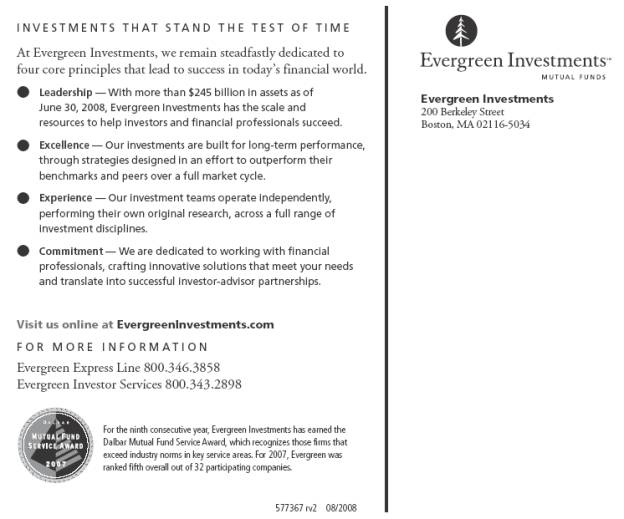
577367 rv2 08/2008
Item 2 - Code of Ethics
Not required for this semi-annual filing.
Item 3 - Audit Committee Financial Expert
Not required for this semi-annual filing.
Items 4 – Principal Accountant Fees and Services
Not required for this semi-annual filing.
Items 5 – Audit Committee of Listed Registrants
Not applicable.
Item 6 – Schedule of Investments
Please see schedule of investments contained in the Report to Stockholders included under Item 1 of this Form N-CSR.
Item 7 – Disclosure of Proxy Voting Policies and Procedures for Closed-End Management Investment Companies.
Not applicable.
Item 8 – Portfolio Managers of Closed-End Management Investment Companies.
Not applicable.
Item 9 – Purchases of Equity Securities by Closed-End Management Investment Company and Affiliated Purchasers.
Not applicable.
Item 10 – Submission of Matters to a Vote of Security Holders
There have been no material changes to the procedures by which shareholders may recommend nominees to the Registrant’s board of trustees that have been implemented since the Registrant last provided disclosure in response to the requirements of this Item.
Item 11 - Controls and Procedures
(a) | The Registrant’s principal executive officer and principal financial officer have evaluated the Registrant’s disclosure controls and procedures (as defined in Rule 30a-3(c) under the Investment Company Act of 1940) within 90 days of this filing and have concluded that the Registrant’s disclosure controls and procedures were effective, as of that date, in ensuring that information required to be disclosed by the Registrant in this Form N-CSR was recorded, processed, summarized, and reported timely. |
(b) | There has been no changes in the Registrant’s internal controls over financial reporting (as defined in Rule 30a-3(d) under the Investment Company Act of 1940) that occurred during the second fiscal quarter of the period covered by this report that has materially affected, or is reasonable likely to affect, the Registrant’s internal control over financial reporting . |
Item 12 - Exhibits
File the exhibits listed below as part of this Form. Letter or number the exhibits in the sequence indicated.
(a) | Any code of ethics, or amendment thereto, that is the subject of the disclosure required by Item 2, to the extent that the Registrant intends to satisfy the Item 2 requirements through filing of an exhibit. |
(b)(1) | Separate certifications for the Registrant’s principal executive officer and principal financial officer, as required by Section 302 of the Sarbanes-Oxley Act of 2002 and Rule 30a-2(a) under the Investment Company Act of 1940, are attached as EX99.CERT. |
(b)(2) | Separate certifications for the Registrant’s principal executive officer and principal financial officer, as required by Section 1350 of Title 18 of United States Code, as adopted pursuant to Section 906 of |
the Sarbanes-Oxley Act of 2002, and Rule 30a-2(b) under the Investment Company Act of 1940, are attached as EX99.906CERT. The certifications furnished pursuant to this paragraph are not deemed to be “filed” for purposes of Section 18 of the Securities Exchange Act of 1934, or otherwise subject to the liability of that section. Such certifications are not deemed to be incorporated by reference into any filing under the Securities Act of 1933 or the Securities Exchange Act of 1934, except to the extent that the Registrant specifically incorporates them by reference.
Pursuant to the requirements of the Securities Exchange Act of 1934 and the Investment Company Act of 1940, the Registrant has duly caused this report to be signed on its behalf by the undersigned, thereunto duly authorized.
Evergreen Equity Trust | | |
By: | | | | |
|
| | | |
| Dennis H. Ferro,
Principal Executive Officer | | | |
Date: August 29, 2008
Pursuant to the requirements of the Securities Exchange Act of 1934 and the Investment Company Act of 1940, this report has been signed below by the following persons on behalf of the Registrant and in the capacities and on the dates indicated.
| | | |
By: | | | | |
|
| | | |
| Dennis H. Ferro,
Principal Executive Officer | | | |
Date: August 29, 2008
| | | |
By: | | | | |
|
| | | |
| Jeremy DePalma
Principal Financial Officer | | | |
Date: August 29, 2008
